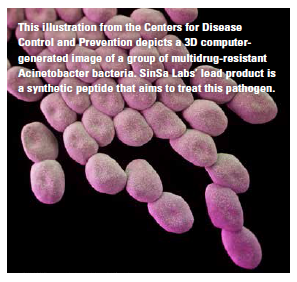A New Way to Address Drug-Resistant Infections
 Magnus Precht, CEO and Co-founder of SinSa Labs, talks about his company’s work to develop a new class of antibiotics engineered to avert antibiotic resistance.
Magnus Precht, CEO and Co-founder of SinSa Labs, talks about his company’s work to develop a new class of antibiotics engineered to avert antibiotic resistance.
Experts say in the future, the crisis in antibiotic resistance will be in E. coli, Klebsiella, pseudomona, and other Gram-negative infections. Now a new company, SinSa Labs, founded in 2014, thinks it has the answer to address these more difficult-to-beat bacteria.
The company’s platform technology, Spearhead Antibiotics, is able to exploit the weaknesses of the bacteria, making it possible to produce antibiotics that avoid the development of resistance. The company is able break down the lipopolysaccharide (LPS) barrier attached to the cell wall of Gram-negative bacteria. SinSa’s molecules embed into the inner membrane, which becomes leaky and loses its membrane potential.
SinSa Labs has designed small peptides and small organic molecules that kill bacteria and fungi. These novel molecules appear to be effective in destroying Gram-negative and Gram-positive bacteria such as carbapenem-resistant enterobacteriaceae (CRE), methicillin-resistant staphylococcus aureus (MRSA), vancomycin resistant enterococcus (VRE), mycobacterium tuberculosis (TB), as well as the Enterococcus faecium, Staphylococcus aureus, Klebsiella pneumoniae, Acinetobacter baumannii, Pseudomonas aeruginosa, and Enterobacteria species.
The company’s lead product is Dorzidiv, a synthetic peptide bioengineered for treating antibiotic-resistent Acinetobacter baumannii infections. Animal studies for this indication are ongoing. The company has tested Dorzidiv against 15 clinical strains of this highly resistant bacteria.
Magnus Precht, CEO and co-founder of SinSa Labs, says the company will begin Phase I human trials in about a year.
An important aspect of Dorzidiv, he says, is that it is not sensed by human cells and has no effect on them. This means it is specific to the bacteria only and causes few side effects.
Mr. Precht says Acinetobacter infections affect about 10,000 patients in the United States every year and the mortality rate is very high and is increasing rapidly over time.
 Dorzidiv qualifies as an orphan drug and the company will seek breakthrough designation with the FDA.
Dorzidiv qualifies as an orphan drug and the company will seek breakthrough designation with the FDA.
Acinetobacter is a group of bacteria commonly found in soil and water. While there are many types, of Acinetobacter, all of which can cause human disease, Acinetobacter baumannii accounts for about 80% of reported infections, according to Centers for Disease Control and Prevention.
Outbreaks of Acinetobacter infections typically occur in intensive care units and healthcare settings with very ill patients.
SinSa Labs also has research programs looking at carbapenem-resistant enterobacteriaceae, including Klebsiella and Escherichia coli. These are found in the intestines or in the environment. But if these bacteria get into areas of the body other than the intestines, they can cause bloodstream infections, wound infections, pneumonia, urinary tract infections, and meningitis.
“These infections have a mortality rate of up to 50% once they reach the bloodstream," Mr. Precht says.
The company also is researching a small molecule that acts like a peptide to treat Gram-positive infections.
“But our main focus is on Gram-negative infections," Mr. Precht says. “The entire healthcare sector is waiting for effective treatments against Gram-negative pathogens."
The company is currently seeking Series A funding and Mr. Precht says the company intends to raise $18 million. (PV)
~~~~~~~~~~~~~~~~~~~~
A Look at Hospital Infections
The CDC healthcare-associated infection (HAI) prevalence survey provides an updated national estimate of the overall problem of healthcare-associated infections in U.S. hospitals. Based on a large sample of U.S. acute care hospitals, the survey found that on any given day, about 1 in 25 hospital patients has at least one healthcare-associated infection.
According to the report, there were an estimated 722,000 HAIs in U.S. acute care hospitals in 2011, and about 75,000 hospital patients with HAIs died during their hospitalizations. More than half of all HAIs occurred outside of the intensive care unit.
Efforts to address hospital infections appear to be working. A report from the CDC indicates reductions at the national level in 2013 for nearly all infections:
A 46% decrease in central line-associated bloodstream infections between 2008
and 2013.
A 19% decrease in select surgical site
infections related to the 10 select
procedures tracked in the report between 2008 and 2013.
A 6% decrease in catheter-associated
urinary tract infections between 2009
and 2013.
An 8% decrease in hospital-onset MRSA bacteremia between 2011 and 2013.
A 10% decrease in hospital-onset C. difficile infections between 2011 and 2013.
Source: Centers for Disease Control Prevention










